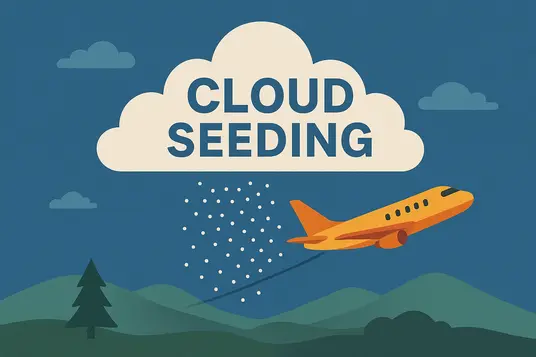
During the UPSC Prelims 2025, a question related to cloud seeding chemicals surprised many aspirants. With the launch of the first cloud seeding experiment in Delhi, the term may seem technical or niche but is now surfaced to public policy and environmental science discussions.
Whether it is to address drought management, hail reduction or climate change, weather modification technologies are increasingly relevant not just for scientists, but also civil service aspirants.
Let’s consider cloud seeding, the technologies used to seed clouds, the chemicals/accountants used, and its relevance for India and the world.
What is Cloud seeding?
As defined by the World Meteorological Organization (WMO) –
“Cloud seeding is a type of weather modification that allows for people to disperse substances into the atmosphere to induce or increase precipitation.”
How it works
Scientists can trigger the action of raining on dry areas or reduce air pollution by utilizing chemicals like silver iodide, dry ice, or plain salt. Although it is being touted as a significant breakthrough in climate resilience, cloud seeding is not without controversy due to ecological fallout and uncertain efficacy.
India’s undertaking of cloud-seeding in Delhi is a banner event in utilizing science to address urban water shortages, particularly during the winter and dry weather months.
By using chemicals like silver iodide, dry ice, or common salt, scientists attempt to stimulate rainfall in dry regions or reduce pollution levels. While some hail it as a climate-resilience breakthrough, others remain cautious about its ecological impact.
As India and the world explore this path, it’s essential to understand cloud seeding and the other advanced weather modification technologies that are shaping climate strategy—and possibly, your next UPSC paper.
1. Fog Dissipation Systems
This tech is used at airports, highways, and defense bases to break up dense fog.
- Uses: Burners, dry ice, or silver iodide
- Purpose: Improve visibility in low-level clouds (fog)
- Similar to cloud seeding but targets surface-level weather
For Example: India has tested this at IGI Airport, Delhi during peak winter.
2. Hail Suppression Technology
Hail can damage crops. This tech reduces hailstone size using rockets or drones.
- Chemicals: Silver iodide or potassium iodide
- Method: Dispersed into hail-forming clouds
- Countries like Russia and China have used it widely
With rising crop insurance costs, India may consider this soon.
3. Weather Modification Drones
UAE, China, and even India are developing drones for weather control.
- What they do: Carry cloud seeding flares or sensors
- Benefit: More accurate and cost-effective than aircraft
- Bonus: Low altitude access to inaccessible areas
You can also check how drone tech is used in other sectors on our site:
Latest Drone Innovations in India
4. Ionization-Based Artificial Rain
This chemical-free method involves charging the atmosphere from the ground.
- Setup: Tall towers release negative ions
- Outcome: Ions attract water vapor → Rain clouds form
- Used in: UAE, Mexico
No silver iodide needed. It’s environment-friendly and futuristic.
5. Cyclone Suppression Experiments
Still in research, these methods aim to reduce storm intensity.
- Techniques:
- Ocean cooling using microbubbles
- Sulfur aerosol spraying to disrupt cyclone formation
- Status: Theoretical, but in active study by global climate labs
Climate change is forcing innovation. This tech may be the future.
6. Super Absorbent Polymers (SAPs)
These are soil-enhancing tools, not weather tech—but still valuable in drought.
- What they do: Absorb water and swell, storing moisture in soil
- Used in: Rajasthan, Israel, and African drylands
- Benefit: Increased crop yield in low rainfall zones
7. Geoengineering Techniques
These large-scale climate-altering technologies are controversial, yet powerful.
- Examples:
- Solar Radiation Management (stratospheric aerosols)
- Carbon Capture and Storage (CCS)
- Goal: Control Earth’s temperature and slow climate change
Note: Ethics, governance, and global cooperation remain major hurdles.
What Chemicals Are Used in Cloud Seeding?
Since UPSC 2025 asked this, here’s a quick fact:
- Commonly used agents:
- Silver Iodide (AgI)
- Potassium Iodide (KI)
- Dry Ice (Solid CO₂)
- Calcium Chloride
- Sodium Chloride (common salt)
Cloud Seeding and Policy Relevancy in India
Cloud seeding signifies policy relevancy that has implications for UPSC aims in India:
- Delhi conducted its first cloud seeding experimentation during winter 2025.
- Maharashtra and Karnataka have pilot projects in water-scarce regions.
- Cloud seeding corresponds to India’s National Action Plan on Climate Change (NAPCC).
It confirms that science and governance intersect with environmental policy, a prevalent integration in GS Paper 3 (Science & Technology).
From Rain Control to Climate Crisis
Cloud seeding, fog dissipation, drones, and ionization are no longer futuristic. They are real time technologies, being implemented and advancing by governments:
- In India: Delhi cloud seeding, agriculture dependent hail mitigation.
- UAE: Drones for rain inducing enhancement.
- China and Russia: Hail suppression and cyclone studies.
For the UPSC aims prioritizing these trends are essential practice for current affairs, environment, and for science and technology related topics on the exam.
Takeaways for the UPSC Aspirants
Combine Science with Current Affairs: To be tested on cloud seeding highlights the merger of science with policy and environmental appreciation in academia and beyond.
It’s not only science vis-a-vis strategies: Every intervention involving climate has some environmental, governance, and displacement implications.
Be infused by global developments. International trials in UAE, China, and Mexico could fill comparative vantage points in assignments during contributions to the mains.
Consider Prelims Processor Equally: Chemistry, processes, and policy relevance keep in mind along the process of pre exam preparation for the prelims and mains.
Conclusion
Cloud seeding and related weather modification technologies are not purely science fiction. They are real, evolving, and increasingly being deployed as part of India’s approach to climate and water governance. From the first-ever cloud seeding experiment in Delhi, to experiments in cyclone suppression, and drone-seeding artificial rain, these examples represent the convergence of science, policy, and governance to address environmental challenges.
For students preparing for UPSC examinations, delving into these technologies and experiments is critical. Knowledge about cloud seeding in terms of current affairs, science and technology, knowledge of environmental policies, and understanding disaster management policies are all core aspects of the Prelims, Mains, and Interviews.
In addressing the questions of effectiveness, environmental impact, and ethical concerns regarding technology examining ongoing climate experiments are a means to demonstrate India’s ambition to build climate resilience and innovation. By engaging in these activities, the aspirants can demonstrate an analytical approach to answering questions that bridge the gap between theory and practice.
Ultimately, cloud seeding is not just about raindrop formation. It is a signal of India’s scientific ambitions, the foresight of policy, and the increasing relevance of technology to governance. For students, policymakers, and citizens, it is a reminder that knowledge, awareness, and ultimately flexibility are essential to navigate 21st-century environmental and societal challenges.
Stay updated with topics like this by checking out our UPSC Science & Tech section.
Got questions or want us to cover another UPSC topic? Drop it in the comments!
FAQ’s
Cloud seeding is weather modification using various chemicals (e.g. silver iodide or dry ice) to induce or enhance precipitation.
Silver iodide, potassium iodide, dry ice, calcium chloride, and sodium chloride are the most common agents.
Yes, Delhi launched its first cloud seeding experiment in 2025 and it is not new in other states, pilot projects have been made in Maharashtra and Karnataka.
Fog dissipation systems, hail suppression, weather modification drones, ionization based artificial rain, cyclone suppression, and geoengineering techniques.
It brings together science, policy and environmental consciousness and is an issue that is relevant to both GS Paper 3 and current affairs, so it is extremely important for both Prelims and Mains exams
What is cloud seeding and how does it work?
Cloud seeding is weather modification using various chemicals (e.g. silver iodide or dry ice) to induce or enhance precipitation.
